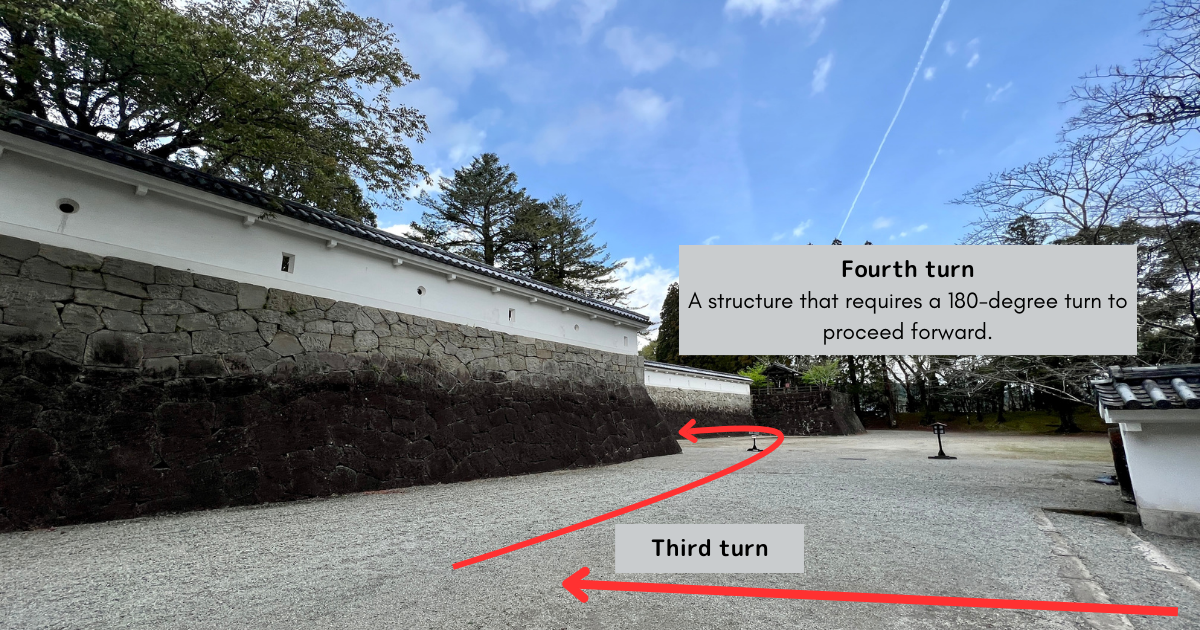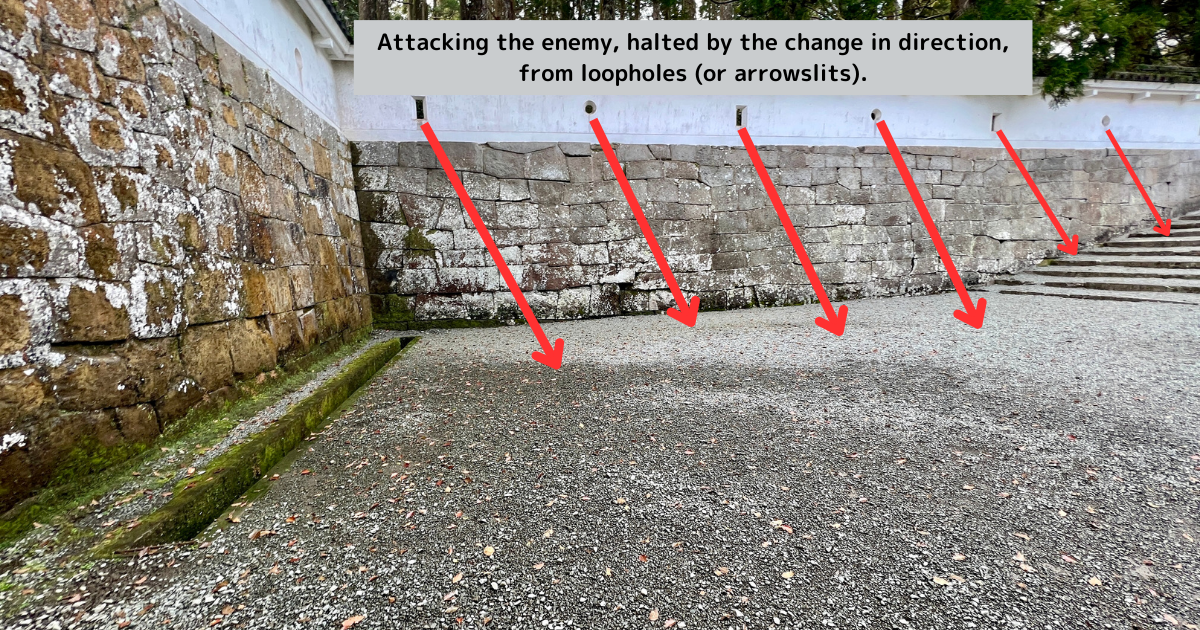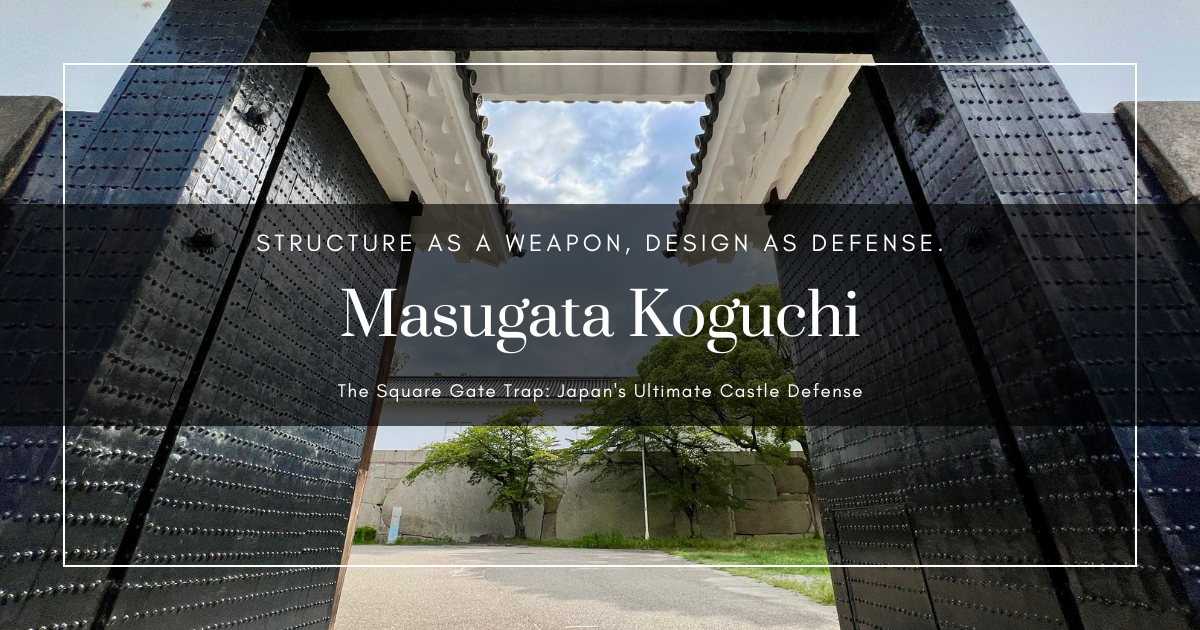Why Castle Entrances Were Never Straight

When visiting Japanese castles, you may encounter places where you must make a sharp right-angle turn immediately after passing through a gate. Have you ever wondered why the path isn’t straight?


This structure is called “masugata koguchi.” Developed in the late Sengoku period, it is known as the “ultimate koguchi” or “the perfection of castle gate defense.”
This article explains the structure, defensive functions, and historical development of masugata koguchi. Understanding this design will deepen your appreciation of castle architecture during your visits.
What Is Masugata Koguchi?
Masugata koguchi is a defensive structure featuring a square-shaped space at a castle entrance (koguchi).
The word “masu” refers to a square wooden measuring box traditionally used for rice. The space was named “masugata” because it resembles this square shape.

Basic Structure
The basic components of masugata koguchi are:

- First Gate (Koraimon, etc.): The outer gate
- Square Space (Masugata): The enclosed square area
- Second Gate (Yaguramon, etc.): The inner gate
After breaking through the first gate, enemies had to make a right-angle turn within the masugata and then breach the second gate to enter the castle. During this time, they would face attacks from defenders positioned on walls surrounding them on three sides.
Outer Masugata and Inner Masugata
Masugata koguchi are classified as either “outer masugata” or “inner masugata” based on their position.
Outer masugata (soto-masugata) projects outward from the bailey. When viewed from outside the castle, a square space extends in front of the gate.

Inner masugata (uchi-masugata) is contained within the bailey. After passing through the first gate, the masugata space opens up inside the bailey.

When exploring castles, observe whether the masugata extends outside or sits inside the defensive wall.
Left Turn and Right Turn
In masugata koguchi, a right-angle turn is required when moving from the first gate to the second gate. This turn can be either a “left turn” or a “right turn.”

Right-turn designs (turning right from the attacker’s perspective) are more common in Japanese castles. Castles with left-turn masugata koguchi, such as Osaka Castle and Odawara Castle, are relatively rare.
Defensive Functions of Masugata Koguchi
Masugata koguchi is called the “ultimate koguchi” because of its excellent defensive capabilities.
Slowing Enemy Advance
The structure forces enemies to slow down since they cannot proceed straight. When attacking with a large army, the narrow gate and required turns disrupt formations and delay progress.
At Obi Castle in Miyazaki Prefecture, masugata koguchi were placed along the route from the main gate to the main enclosure, effectively designed to slow enemy advances.

While most designs require 90-degree turns, some sections at Obi Castle force 180-degree turns. Attackers must completely halt their momentum to proceed.


Because conquering a masugata koguchi takes time, defenders gain opportunities to wait for reinforcements or implement other defensive measures. Meanwhile, attackers become exhausted from prolonged combat and their morale drops.
Concentrated Attack from Three Sides (Kill Zone)
The key feature of masugata koguchi is its ability to trap enemies in a “kill zone.”
Enemies who enter the masugata find themselves surrounded by walls on three sides—left, right, and front. Archers and gunners positioned atop these walls can unleash concentrated fire. Attackers who stop to change direction become easy targets from above.

History of Masugata Koguchi
Masugata koguchi emerged in the late Sengoku period, around the Momoyama era. Earlier castle entrances had simpler designs that were less effective at stopping enemy intrusion.
After the Battle of Sekigahara in 1600, masugata koguchi developed rapidly. Nearly all early modern castles built during the period of national unification adopted this design. Todo Takatora, renowned as a master castle builder, used masugata koguchi in many castles including Imabari Castle, greatly contributing to its widespread adoption.
The scale of masugata koguchi varied by castle, but some were built on a grand scale to demonstrate authority or strengthen defenses. Edo Castle’s Outer Sakurada Gate is said to have the largest surviving masugata, measuring approximately 27 by 38 meters (about 1,060 square meters). Today, this area is part of the Imperial Palace Outer Garden (the plaza in front of the Imperial Palace), located near Sakuradamon Station and popular among Imperial Palace runners.

Structure as a Weapon, Design as Defense
Japanese castles embody a unique defensive philosophy that doesn’t rely solely on weapons and military strength. They leverage terrain for defense and use architectural ingenuity to confuse enemies. Masugata koguchi is the ultimate symbol of this approach.
The rational design of luring enemies into a square space and attacking from three sides represents defensive technology refined through the Sengoku period.
When you visit a castle, pay attention to the structure beyond the gates. If you find a place where you must turn at a right angle, that’s a masugata koguchi. Consider whether it’s an outer or inner masugata, a right turn or left turn—observing these details makes castle visits even more interesting.

